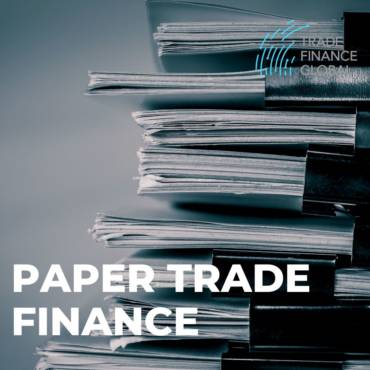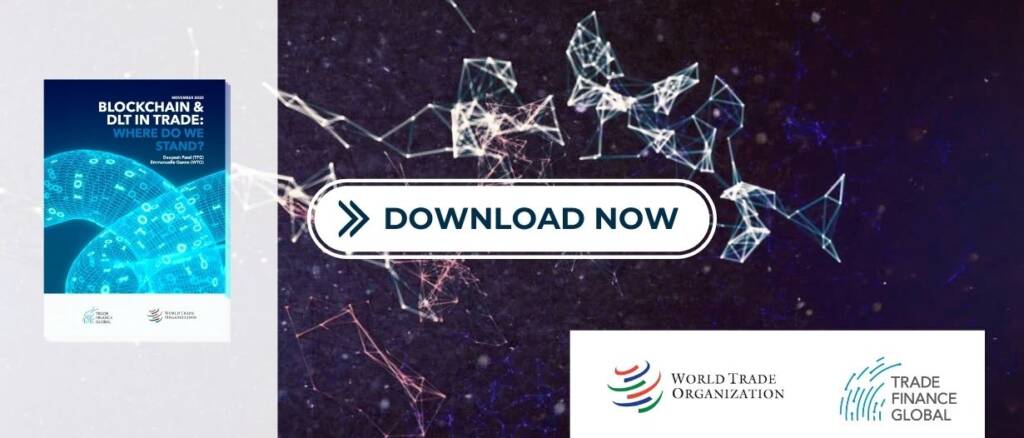Estimated reading time: 15 minutes
This article discusses the potential benefits of using blockchain technology for trade finance activities and highlights the significant challenges facing blockchain adoption.
Traditional paper-based trade finance systems
Trade finance serves as the lifeblood of international trade in goods and services by
enabling transactions between buyers and sellers worldwide. Trade finance provides the credit, payment guarantee, and insurance needed to facilitate the transaction on terms that would satisfy all parties.
One of the difficulties involved with trade finance is the large volume of paper documents that make up much of the information flow between trading parties.

Most of the trade finance activities involve a substantial amount of physical paperwork being shuffled back and forth between the importer, exporter, importer’s bank, exporter’s bank, shipping company, receiving company, local shippers, insurers, and others.
This reliance on documents usually has drawbacks, including the cost and time required to prepare, transmit, and check these documents. Paper documents may also be open to errors and even forgery.
COVID-19 impact
Furthermore, the COVID-19 outbreak has impacted different trade finance steps, including deal origination and distribution, negotiable instruments, document transmission, authorised signatures, and shipping.
Nowadays, several banks and financial institutions worldwide are trying to quickly scale their digital initiatives to move toward a world where digitalisation is central to every interaction.
Banks are looking to utilise technology to streamline trade by creating digital ecosystems that reduce costs and increase trade finance efficiency by replacing paper with digital data flows.
The International Chamber of Commerce (ICC) survey conducted in April 2020 indicated that banks are focusing on the rapid adoption of blockchain, the digitisation of documentation, and automated processing and handling software in response to the COVID-19 pandemic.

Potential benefits of blockchain technology for trade finance
There has been widespread optimism regarding the application of blockchain in the banking industry. Many industry practitioners argue that blockchain technology can disrupt business and financial services in the way the internet disrupted offline commerce.
Blockchain technology holds the potential to change business processes by redefining value chain interactions, reducing operational complexity, and reducing transaction costs.
The new technology entails a distributed database that autonomously maintains a continuously growing list of transactions recorded in units called blocks, and secured from tampering and revision.
Each block contains a timestamp and a link to a previous block. The blockchain combines several computer technologies, including distributed data storage, point-to-point transmission, consensus mechanisms, and encryption algorithms.
Most blockchain networks aim to create a database system in which decentralised agents or institutions can jointly record information and maintain it, with no individual party exercising continuous market power or control.
The basic idea of blockchain technology is to decentralise data storage so that such data cannot be owned, controlled, or manipulated by a central actor.
Blockchains proponents argue that the blockchain, serving as a shared ledger (database), may facilitate trade finance using its distributed network, which maintains transparent records of critical transactions among trading stakeholders. The blockchain could potentially enhance transaction transparency and supply chain traceability.
Trade finance practitioners claim that moving to paperless trade would be hugely beneficial in supporting the supply chain through reduced costs, error-free documentation, and fast transfer of documents to customers.
Accordingly, banks would generate more revenue from trade finance activities by attracting businesses not participating in cross-border trade and companies selectively shifting from open accounts to documentary credit transactions to seek greater risk mitigation.
It is assumed that blockchain technology can address the shortcomings of the traditional paper-based trade finance system by digitising, optimising, and shortening the trade finance process and making it more transparent, cost-efficient, and accessible.
By digitising documents, banks and corporates would reduce the need to collect, scan, and re-key data, leading to greater efficiency in the trade finance process.
Furthermore, as blockchain allows for simultaneous access to critical documents by all authorised parties anytime or anywhere, it might eliminate manual tracking and reconciliation of paper trails and bilateral e-mails.
Using smart contracts in international trade
Blockchain technology has permitted the emergence of “smart contracts”. Smart contracts are contracts based on decentralised consensus as well as tamper-proof algorithmic executions.
Smart contracts refer to a series of digital agreements, including terms and conditions promised by contract participants.
With its programmable protocol, the smart contract allows the execution and automation of contract terms. The essence of smart contracts is that they can enable parties who have no trust in each other to collaborate without the need for a trusted intermediary like a bank.
Smart contracts may be programmed according to the terms of contractual agreements, and payments may be triggered by predetermined events.
Various research indicated that smart contracts could reduce costs for gathering and processing information, drafting and negotiating contracts, monitoring and enforcing agreements, and managing relationships, allowing for more market-based governance structures under certain circumstances.
Smart contracts generally may increase trust in data due to the secured storage system and guarantee operations to be executed automatically without intermediaries involved in making the payments. Thus, smart contracts and blockchain technology seem to be appropriate for international trade activities in which the importer and export have little – if any – trust in each other.
Smart contracts could secure trust among parties in open account trading, enhance transparency in trade transactions, guarantee data reliability, reduce the risk of errors or fraud, and facilitate the exchange of payments.
Initiatives to apply blockchain technology in trade finance
Blockchain technology is still at an early stage of development, and further research is needed to enhance its efficiency and security.
Several business institutions have established their own blockchain laboratories, working in close collaboration with blockchain platforms, and published a series of studies on this topic.
In 2016, Barclays announced its cooperation with a fintech start-up named ‘Wave’ to initiate the supposed first global trade transaction with its blockchain-based letter of credit project using the Wave blockchain platform. The transaction guaranteed the trade of almost USD100,000 worth of cheese and butter between Irish agricultural food co-operative Ornua and the Seychelles Trading Company.
In 2018, HSBC announced that it completed a trade finance transaction to issue an entirely digitalised letter of credit, using blockchain technology. In this transaction, HSBC Singapore acted as the issuing bank of the letter of credit, and ING Geneva served as the nominated bank.
During the same year, Banco Bilbao Vizcaya Argentaria (BBVA), a Spanish bank, used blockchain technology as a substitute for traditional trade documents. This project was related to the importation of frozen tuna from Mexico. The letter of credit for this project was issued by BBVA. In this transaction, the blockchain solution provider utilised digitised documentation and electronic signatures to replace traditional paper-based trade documents.
In 2020, Standard Chartered and DBS Bank Ltd announced that they have kicked off a project to use a blockchain network to register trade finance transactions with the support of twelve other banks, including ABN Amro, ANZ, CIMB, Deutsche Bank, ICICI, Lloyds, Maybank, Natixis, OCBC, Rabobank, SMBC, and UOB.
DBS Bank Ltd and Standard Chartered mentioned that they would work with the Association Banks of Singapore to implement the trade finance registry within Singapore before expanding it globally to cover major trade corridors at a later stage.
IBM has been spearheading the application of blockchain and smart contracts to trade finance. In 2017, IBM and Maersk, cooperating with Hyperledger Fabric, announced the completion of an end-to-end digitalised supply chain model using blockchain technology, which involves trading parties and various ports and customs authorities.
Furthermore, different types of blockchain consortiums have emerged to promote blockchain technology and its applications. The development of trade finance platforms was carried out by several large banking consortia in collaboration with technology providers such as IBM Hyperledger or R3 Corda.
Large banking institutions have opted for cooperation because digital platforms could be efficient and beneficial to clients if they reach a sufficient size and market coverage. The most well-known blockchain consortiums related to trade finance are we.trade, Marco Polo, Contour, Komgo, India Trade Connect, and eTradeConnect.
In May 2022, we.trade announced that was ceasing operations as a result of waning cash flow.
Challenges facing the implementation of blockchain in trade finance
While the goal is to reach complete digitalisation, achieving this target is likely to take some time, assuming it can be fully accomplished. As it could be recognised, the adoption of blockchain technology in trade finance has been slow.
This slow adoption of the blockchain may be attributed to several factors. The hereunder factors seem to be among the principal causes of the weak adoption of blockchain technology in the trade finance field.
1. The lack of standard protocol for blockchain networks
One of the primary problems related to the development of digital platforms in trade finance is that each platform developer is trying to do something different.
Even within the blockchain community, there are different coding languages, consensus mechanisms, and privacy measures, creating silos that are unable to connect with each other. This problem leads to a lack of interoperability and standardisation between various blockchain platforms.
Blockchain is not a technology that individual firms can deploy on their own; it is crucial for multiple stakeholders to work together. Platform developers and participants should avoid fragmentation that could limit the benefits of these platforms for the trade ecosystem and prevent its widespread adoption.
The future of trade digitalisation relies on interoperability and the development of end-to-end solutions.
A crucial step towards end-to-end trade digitalisation is creating an ecosystem that allows seamless exchanges of data between existing platforms. Accordingly, there is a need for the development of a global standard protocol for blockchain platforms in order for these platforms to be able to communicate directly with each other.
If each party in the trade finance network maintains its own proprietary source of information – as it does today – digital documentation of each transaction would need to be checked and re-entered manually at every step of the process.
Having many different centralised systems globally would create localised data centres that do not interoperate with each other.
The existing consortiums and platforms appear to be digital islands, with paper documents often serving as a bridge to each island. For blockchain technology to achieve its expected benefits in trade finance, all of the ecosystem participants, including trading companies, logistics and shipping firms, banks, and customs, need to agree on a uniform set of technology standards and business rules.
There are several initiatives working towards creating a set of digital standards for trade. Some of these are focused on particular sectors or geographies, while others are more general.
The ICC Digital Standards Initiative, which was launched in September 2020 with the support of Enterprise Singapore and the Asian Development Bank and the participation of the World Trade Organization (WTO), is an important step toward the development of globally accepted digital standards for trade.
2. The need for legal systems to recognise digital documents in trade
The discussion of the digitalisation of trade would not be complete without mentioning the importance of building a harmonised regulatory environment that can support the digitalisation of international trade.
It could be said that a considerable challenge facing the adoption of the blockchain across the trade industry is related to the uncertainty over the legal status of e-documents among legal systems.
Most of the legal systems worldwide are likely to recognise the status of paper documents in international trade. However, it appears that many jurisdictions do not recognise e-signatures and e-documents for trade activities.
The ICC banking commission report about the legal status of electronic bills of lading in ten jurisdictions, including the UK, USA, Germany, Netherlands, UAE, China, Singapore, Brazil, India, and Russia, revealed that the legal status of electronic bills of lading is still unclear in many jurisdictions.
The report indicated that most of the above-mentioned surveyed countries have some form of legislation, allowing contracts to be created and signed electronically. However, only the USA (New York law) recognises electronic bills of lading as having the same legal status and enforceability as tangible bills of lading and other documents of title.
The ICC banking commission report mentioned that a bank acting as an issuing or nominated bank under a documentary credit may be reluctant to accept the presentation of an electronic bill of lading because that might jeopardise the bank’s right to reimbursement.
Hence, the legal requirements prescribing the use of traditional paper-based documents seem to be an essential barrier to the development of blockchain technology in the trade industry.
The potential of blockchain technology to facilitate international trade will only be realised if regulations evolve to support the large-scale deployment of the technology.
International organisations, such as the ICC and WTO, need to encourage national governments to adopt the model law proposed by the United Nations Commission on International Trade Law (UNCITRAL) and similar initiatives designed to facilitate the use of electronic documents in trade in order to have a harmonised international trade law framework that might pave the way for the digitalisation of trade.
3. High costs associated with adopting and operating the blockchain
The cost of creating and maintaining a blockchain network is considered an obstacle to the wide adoption of this technology. The speed and effectiveness with which blockchain networks can execute peer-to-peer transactions come at a high aggregate cost.
The high cost of blockchain usually results from several factors. First, blockchain networks rely on intensive computing power and hence consume much electricity in order to run.
The majority of blockchains require all users to solve complex mathematical puzzles and need tremendous computing power to verify and process transactions and secure the network.
Blockchain mining schemes favour and reward the fastest miner who gets the right to record the transaction while others only waste electric power in competing for mining efforts.
Second, costs arise from the performance of each node (device) of the same tasks as every other node on its own copy of the data in an attempt to be the first to find a solution. Miners usually use huge computer rigs with multiple servers to keep the network ticking over, and that process generally does not come cheap.
Third, there is a challenge for companies regarding how to integrate blockchain with their existing information system(s). In most cases, if they decide to use blockchain, organisations are required to completely restructure their existing information system or design a way to integrate the two technologies.
The high costs associated with acquiring and maintaining the blockchain are likely to prevent its adoption by many governmental entities as well as private firms.
4. Information transmission and privacy concerns
Blockchain has some fundamental privacy problems by virtue of its design.
The blockchain typically enables trading parties (e.g., carriers, exporters, importers, and banks) to share distributed ledgers for trade finance transactions. The distributed aspect of a blockchain means that each party that processes transactions and builds the blockchain has access to the blockchain transactions data.
Consequently, it is expected that the blockchain database would allow the sharing of confidential transaction information contained in bills of lading, letters of credit, and other shipping documents with other members of the blockchain network.
In this manner, a blockchain would be acting as an open ledger that is visible to everyone. This would lead to an uncomfortable business environment for several organisations as the terms and conditions of their trade transactions might be available to other members of the blockchain network.
Thus, it seems that the distributed ledger characteristics need to be remodelled to allow restricted access to data and be accessible only to parties who are authorised to view it.
5. Compliance policies and procedures
Another challenge for blockchain technology is whether the blockchain can address the growing costs and complexities of complying with financial crime regulations in trade finance. For banks, in particular, technologies must support regulatory compliance requirements.
Concerns regarding compliance with the financial crime regulations exist because blockchain technology allows for less physical examination of documents. For trade finance transactions, a user would need to input into the blockchain ledger relevant information available in the bills of lading, letters of credit, and other shipping documents.
Failure to enter all information relevant to sanctions, even if not all of it is necessary for commercial reasons, may expose all the parties involved in the transaction to sanctions risk.
For example, if the ledger did not contain information that the goods were to be transshipped through a sanctioned country, then others processing the transaction would not know this and, therefore, may process or participate in the transaction in breach of sanctions.
In such a case, banks may be accused of not conducting adequate due diligence if they only screened the electronically available structured data, uploaded and verified by their counterparties, without conducting a review of the underlying documents or the unstructured data.
On the other hand, if a bank decided to mitigate this risk by asking for the underlying documents, it would then undermine the whole purpose for which the blockchain is used, for example, to avoid reliance on the conventional documentary trade system.
Thus, it seems necessary for developers of blockchain networks to get inputs from organisations responsible for monitoring sanctions and trade embargoes, including OFAC and other regulators, to satisfy regulatory expectations.
 Australia
Australia Hong Kong
Hong Kong Japan
Japan Singapore
Singapore United Arab Emirates
United Arab Emirates United States
United States France
France Germany
Germany Ireland
Ireland Netherlands
Netherlands United Kingdom
United Kingdom
















Comments are closed.